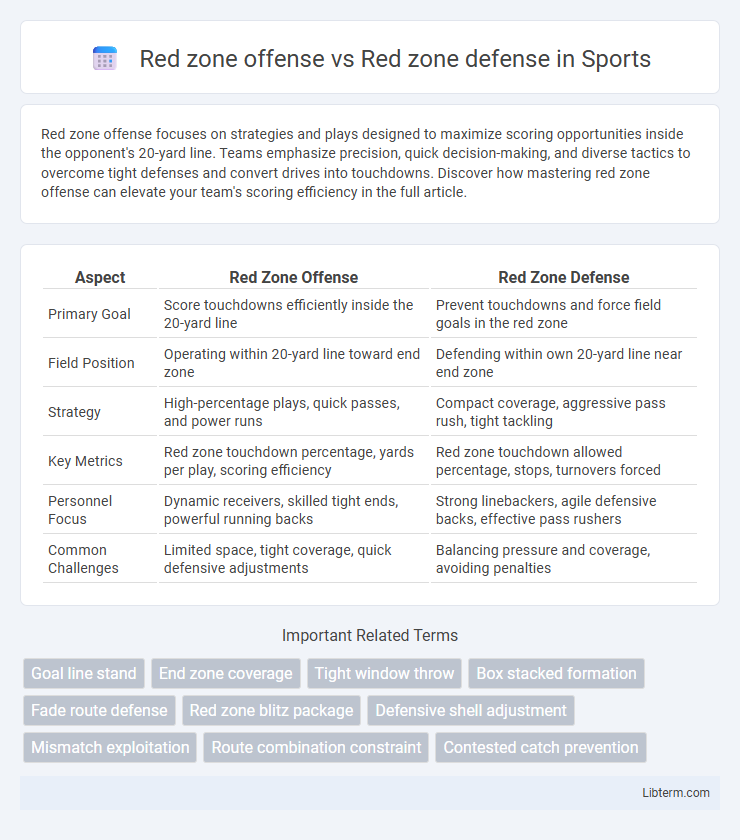Red zone offense focuses on strategies and plays designed to maximize scoring opportunities inside the opponent's 20-yard line. Teams emphasize precision, quick decision-making, and diverse tactics to overcome tight defenses and convert drives into touchdowns. Discover how mastering red zone offense can elevate your team's scoring efficiency in the full article.
Table of Comparison
| Aspect | Red Zone Offense | Red Zone Defense |
|---|---|---|
| Primary Goal | Score touchdowns efficiently inside the 20-yard line | Prevent touchdowns and force field goals in the red zone |
| Field Position | Operating within 20-yard line toward end zone | Defending within own 20-yard line near end zone |
| Strategy | High-percentage plays, quick passes, and power runs | Compact coverage, aggressive pass rush, tight tackling |
| Key Metrics | Red zone touchdown percentage, yards per play, scoring efficiency | Red zone touchdown allowed percentage, stops, turnovers forced |
| Personnel Focus | Dynamic receivers, skilled tight ends, powerful running backs | Strong linebackers, agile defensive backs, effective pass rushers |
| Common Challenges | Limited space, tight coverage, quick defensive adjustments | Balancing pressure and coverage, avoiding penalties |
Understanding the Red Zone: Definition and Importance
The red zone in football refers to the area between the opponent's 20-yard line and the goal line, where the offense aims to score touchdowns rather than field goals. Red zone offense strategies prioritize precision, quick decision-making, and play execution to capitalize on limited space and high-pressure situations. Red zone defense focuses on tightening coverage, forcing turnovers, and minimizing scoring opportunities by controlling the area where the margin for error is smallest.
Key Strategies in Red Zone Offense
Red zone offense centers on precise play calling and exploiting tight spaces to maximize scoring opportunities within the 20-yard line. Key strategies include utilizing quick, high-percentage passes to outmaneuver tight coverage and incorporating power runs to capitalize on short-yardage situations. Effective red zone offenses also emphasize versatile formations and player misdirection to confuse defenses and create open lanes for touchdowns.
Core Tactics for Red Zone Defense
Red zone defense relies on tight coverage, aggressive pass rush, and active linebackers to disrupt quick scoring attempts. Defensive schemes prioritize limiting space, forcing offenses into predictable routes while securing the goal line with multiple defenders in high-leverage positions. Key tactics include zone coverage variations, stunts on the defensive line, and rapid adjustments to offensive formations to prevent touchdowns within the 20-yard line.
Impact of Play Calling Inside the 20-Yard Line
Inside the 20-yard line, play calling in the red zone critically influences scoring efficiency by balancing aggressive passing attacks with calculated runs to exploit short-field advantages. Defensive strategies prioritize limiting high-percentage plays, employing tight coverage and pressure schemes to disrupt rhythm and force turnovers. Effective communication and adaptability between coaches and players during these downs often determine the successful conversion of red zone opportunities into touchdowns rather than field goals.
Player Roles in Red Zone Situations
In red zone offense, the quarterback emphasizes quick decision-making to exploit tight coverage, while wide receivers run precise routes to create separation in limited space. Running backs focus on powerful, decisive runs or pass protection to support the quarterback under intense defensive pressure. Defensively, linebackers and defensive backs prioritize tight coverage and gap assignments, aiming to disrupt timing and force turnovers inside the 20-yard line.
Common Red Zone Offensive Formations
Common red zone offensive formations emphasize maximizing space and creating mismatches within the 20-yard line, often deploying tight ends and slot receivers to exploit short-area routes and quick reads. Formations like the I-formation, single-back sets, and trips formations facilitate versatile play-calling options such as play-action passes, power runs, and quick slants, targeting weak points in the red zone defense. Effective red zone offenses leverage personnel groupings to stretch defenses horizontally and vertically, forcing defensive coordinators to cover tight spaces while anticipating rapid decision-making by the quarterback.
Defensive Alignment and Adjustments in the Red Zone
In the red zone, defensive alignment tightens to reduce scoring opportunities, often deploying heavier personnel near the line of scrimmage to clog running lanes and apply pressure on the quarterback. Defenses frequently adjust by shifting coverage schemes to prioritize quick, disciplined reactions against short-area passes, utilizing zone or man-to-man tactics based on offensive tendencies. These strategic alignments and in-game adjustments are critical for disrupting efficient red zone offenses and forcing field goals instead of touchdowns.
Statistical Trends in Red Zone Efficiency
Red zone offense efficiency often hinges on metrics like yards per play and touchdown conversion rate, with top NFL teams averaging over 60% touchdown efficiency inside the 20-yard line. Conversely, red zone defense success is measured by preventing touchdowns, with elite defenses holding opponents to under 35% red zone touchdown rates. Statistical trends reveal that teams with balanced red zone performance possess higher overall scoring percentages and win rates, emphasizing the critical nature of situational execution within the 20-yard threshold.
Red Zone Turnover Rates and Their Significance
Red zone offense efficiency is critically evaluated by turnover rates, with teams averaging a turnover every 15 to 20 red zone possessions facing significantly reduced scoring opportunities. Red zone defense capitalizes on pressures, forcing turnovers at a rate nearly 30% higher than the league average outside the 20-yard line. High red zone turnover rates correlate strongly with winning percentages, as they limit opponents' touchdown conversions and shift momentum crucially during tight contests.
Best Practices for Success in Red Zone Scenarios
Effective red zone offense prioritizes precision routes and quick decision-making to exploit limited space and tight defensive coverage. Red zone defense emphasizes disciplined zone coverage and aggressive pass rushes to disrupt timing and force turnovers. Success in red zone scenarios hinges on synchronized communication, situational awareness, and adaptive play-calling tailored to opponent tendencies.
Red zone offense Infographic

 libterm.com
libterm.com